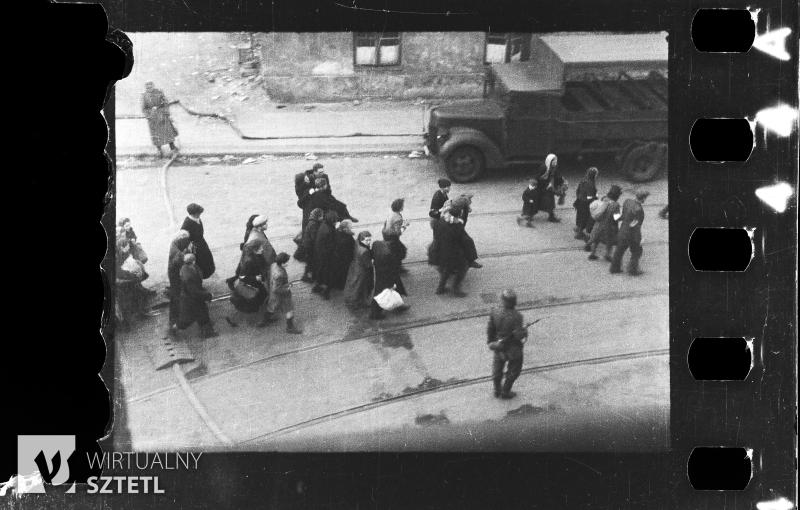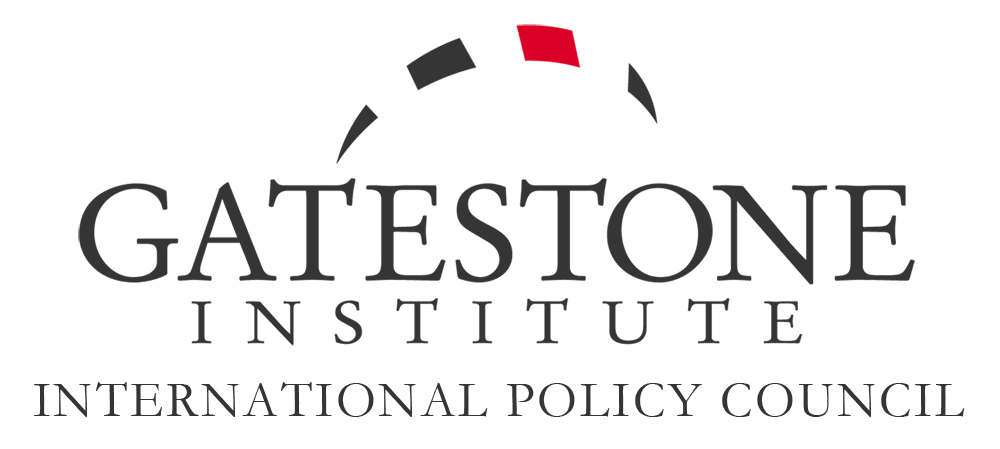
 Od styczniowej samoobrony do powstania. Getto Warszawskie
Od styczniowej samoobrony do powstania. Getto Warszawskie
Klara Jackl, Piotr Ostrowski
19 kwietnia 2023 roku przypada 80. rocznica powstania w getcie warszawskim – największego zbrojnego zrywu Żydów podczas II wojny światowej, a zarazem pierwszego powstania miejskiego w okupowanej Europie. Z tej okazji Muzeum Historii Żydów Polskich POLIN otworzy 17 kwietnia wystawę “Wokół nas morze ognia. Losy żydowskich cywilów podczas powstania w getcie warszawskim”. Oddajemy w niej głos ludności cywilnej, której cichy opór był równie ważny jak ten z bronią w ręku. Poniżej przeczytasz o historii getta i powstania, znajdziesz odnośniki do naszych opracowań i zbiorów historii mówionej, a także poznasz program obchodów rocznicy powstania, którą obchodzimy pod hasłem „Nie bądź obojętny”.
Getto warszawskie
Getto warszawskie było największym gettem w Europie okupowanej przez Niemcy. Okupanci utworzyli je w październiku 1940 r., nakazując przenieść się tam wszystkim żydowskim mieszkańcom Warszawy. Wzniesiony wówczas wokół getta mur objął zaledwie 2% obszaru miasta, choć Żydzi stanowili przed wojną 29% mieszkańców stolicy. Najwyższy stan zagęszczenia getta odnotowano w kwietniu 1941 r. – Niemcy więzili tu wówczas ok. 450 tys. osób. Stopniowo ta liczba zmniejszała się – Żydzi umierali na skutek głodu, chorób czy prześladowań ze strony władz niemieckich. Getta nie można było opuszczać pod karą śmierci.
Wewnętrzna organizacja getta została przez Niemców złożona na barki Judenratu, czyli Rady Żydowskiej. Rada została powołana nie tylko do pełnienia funkcji administracyjnych, ale także represyjnych: początkowo do wyłapywania przymusowych robotników czy ściągania kontrybucji. Beznadziejną sytuację więźniów getta starały się wspierać instytucje samopomocowe, zwłaszcza Żydowska Samopomoc Społeczna.
>> Przeczytaj więcej o działalności samopomocowej kobiet w getcie warszawskim
Mimo zagrożenia, więźniowie getta podejmowali działalność konspiracyjną, polegającą na wsparciu najuboższych, organizowaniu spotkań kulturalnych i naukowych, tajnym nauczaniu, wydawaniu prasy. Z inicjatywy Emanuela Ringelbluma konspiracyjna grupa Oneg Szabat prowadziła archiwum getta – zbierała dokumenty, druki i relacje. Archiwum ukryto w bańkach po mleku i zakopano w ziemi. Zobacz miejsce ukrycia archiwum.
Nieliczni starali się, w miarę możliwości finansowych i kontaktów po „stronie aryjskiej”, uciec z getta i ukryć się po drugiej stronie muru. Niektórzy opiekunowie i opiekunki, w akcie miłości i troski decydowali się na rozstanie z dziećmi w nadziei, że przetrwają one w nieco bezpieczniejszym otoczeniu.
Akcje deportacyjne i ruch oporu w getcie
W lipcu 1942 r. Niemcy zarządzili akcję likwidacyjną. W rzeczywistości oznaczała ona wywiezienie ludności żydowskiej z getta do niemieckiego nazistowskiego ośrodka zagłady Treblinka i jej śmierć w komorach gazowych. Od 22 lipca do 21 września 1942 r. Niemcy wywieźli i zamordowali niemal 300 tys. Żydów. Na początku tej akcji przewodniczący Judenratu Adam Czerniaków, odmówiwszy podpisania obwieszczenia o przymusowym wysiedleniu Żydów, czyli deportacji, popełnił samobójstwo.
Jesienią 1942 r. w tzw. getcie szczątkowym pozostało już tylko około 60 tys. Żydów. Byli to głównie ludzie młodzi, zatrudnieni w niemieckich warsztatach produkcyjnych, tzw. szopach. W atmosferze strachu, terroru i ogólnego przeświadczenia o szybkim końcu, narodził się pomysł zbrojnego oporu przeciwko okupantowi niemieckiemu, aby nie dać się zabrać żywcem na Umschlagplatz. 28 lipca 1942 r. z inicjatywy lewicowych syjonistycznych ruchów młodzieżowych powstała Żydowska Organizacja Bojowa (ŻOB), z Mordechajem Anielewiczem na czele. Wśród bojowników ŻOB-u byli także m. in. Icchak Cukierman, Cywia Lubetkin czy Marek Edelman.
>> Czytaj więcej o działalności Marka Edelmana po II wojnie światowej
Drugą organizacją konspiracyjną działającą w getcie był Żydowski Związek Wojskowy (ŻZW), którym dowodził Paweł Frenkel oraz Leon (Arie) Rodal. Z ŻZW związani byli przedwojenni działacze Nowej Organizacji Syjonistycznej jak Dawid Wdowiński, Michał Stryjkowski i Dawid Szulman oraz członkowie młodzieżowej organizacji Betar.
18 stycznia 1943 r. niemieckie siły policyjne wkroczyły do getta szczątkowego i rozpoczęły łapankę ludzi, która była zaskoczeniem zarówno dla bojowników, jak i cywilów więzionych w getcie. Jednocześnie stała się okazją do pierwszego zbrojnego oporu Żydów. Wkroczenie Niemców odebrano jako początek ostatecznej likwidacji getta.
18 stycznia dostajemy telefon, że nie wracamy na ul. Franciszkańską, ponieważ jest tam obława, selekcja. Już druga wielka selekcja. (…) I wtedy był pierwszy raz gdy Niemcy planowali zniszczyć getto w ogóle, ale natknęli się na bojowników. (…) [Ta selekcja] to był znak, że [Niemcy] planują kompletną likwidację getta – mówiła w wywiadzie z kolekcji Historii Mówionej Muzeum POLIN Halina Aszkenazy-Engelhard.
>> Zobacz wywiad z Haliną Aszkenazy-Engelhard: „To już nie jest ta Warszawa”
Walki trwały kilka dni. Tak zwana samoobrona styczniowa, będąca pierwszą otwartą walką zbrojną na ulicach okupowanej Warszawy, stanowiła przełom psychologiczny, pokazując, że opór zbrojny wobec Niemców jest możliwy, i przyczyniła się do wzrostu autorytetu ŻOB wśród więźniów getta, którzy jednocześnie starali się stawiać opór bierny, np. nie wychodząc z domów na rozkaz Niemców.
W getcie myśmy myśleli, że było straszne zwycięstwo! Bo oni się wycofali, myśmy nie wyszli. Pierwszy raz w naszych życiach nie byliśmy tacy posłuszni i myśleliśmy, że było zwycięstwo, ale to nie było zwycięstwo, [ale] oni wiedzieli, że będzie odpór – wspominał tamte dni w wywiadzie z kolekcji Historii Mówionej Muzeum POLIN Jerry Rawicki.
Czynny opór warszawskich Żydów w styczniu 1943 r. opóźnił ostateczną likwidację getta i dał organizacjom konspiracyjnym czas na przygotowania do powstania.
>> Przeczytaj więcej o samoobronie styczniowej w getcie warszawskim
Powstanie w getcie warszawskim
O świcie, w poniedziałek 19 kwietnia 1943 r., w przeddzień święta Pesach, niemieckie oddziały wkroczyły bramą od strony ul. Nalewki do opustoszałej dzielnicy żydowskiej z zamiarem jej ostatecznej likwidacji. Napotkały zbrojny opór ze strony jej mieszkańców – kilkuset członków ŻOB-u i ŻZW. Rozpoczęło się powstanie w getcie warszawskim.
Mimo małej liczebności oraz niewystarczającego uzbrojenia, powstańcy zadawali straty żołnierzom niemieckim. Ostrzeliwali wkraczające oddziały i obrzucali je granatami i butelkami z benzyną. Ciężkie walki na placu Muranowskim toczył ŻZW pod dowództwem Pawła Frenkla. Wręcz symbolicznego wymiaru nabrał obraz wywieszonych w tym miejscu obok siebie flag polskiej i żydowskiej. Na terenie szopu szczotkarzy w dniach 20-22 kwietnia walczyli bojownicy ŻOB z Markiem Edelmanem na czele oraz oddział ŻZW dowodzony przez Chaima Łopatę. Walki z niemieckimi oddziałami toczyły się także w innych rejonach getta. Tymczasem Niemcy wysadzali w powietrze bunkry, aby uniemożliwić bojownikom przemieszczanie się i łączność. Równocześnie podpalali dom za domem.
>> Przeczytaj więcej o przebiegu i miejscach walk w czasie powstania.
Walki trwały do połowy maja 1943 roku. 8 maja 1943 r. Niemcy otoczyli bunkier komendy ŻOB przy ul. Miłej. Dowodzący Mordechaj Anielewicz razem z innymi bojownikami popełnił samobójstwo. Potem powstańcy prowadzili jeszcze sporadyczne potyczki. Zaledwie kilkudziesięciu udało się wydostać kanałami poza obszar getta. Zobacz miejsce ewakuacji przy ulicy Prostej 51.
Ja wyszedłem pierwszego maja z getta. […] przełożeni wysyłali ludzi, bo wiedzieli, że nie było żadnej w ogóle myśli, że my możemy pokonać Niemców. Nikt o tym nie śnił. […] Żyd był na pierwszym miejscu, na pierwszym miejscu do stracenia. Także nie mieliśmy co stracić właściwie. Tylko to, że zaoszczędzić sobie męczarnie w komorze gazowej – opisywał wyjście z getta w wywiadzie z kolekcji Historii Mówionej Muzeum POLIN jeden z bojowników ŻOB, Symcha Rotem.
>> Zobacz relację Symchy Rotema, bojownika getta: „Nigdy nie wolno tracić nadziei”.
16 maja 1943 r. na rozkaz Jürgena Stroopa została wysadzona Wielka Synagoga na Tłomackiem. Miało być to symboliczne potwierdzenie zdławienia powstania i likwidacji warszawskiego getta przez Niemców.
Ludność cywilna podczas powstania w getcie
Walkę zbrojną przeciwko okupantowi niemieckiemu podjęło kilkaset bojowniczek i bojowców żydowskiego podziemia. Pozostali więźniowie getta, około 50 tysięcy „cywilnych” Żydów przez wiele tygodni ukrywało się w kryjówkach i bunkrach. Pomimo rozpaczy, samotności, głodu, pragnienia i strachu walczyli o każdy kolejny „dzień, godzinę, minutę”. Ich cichy opór był tak samo ważny, jak ten z bronią w ręku. Przez wiele dni pozostali nieuchwytni – zeszli do podziemi i nie podporządkowali się rozkazom Niemców.
[…] jeśli chodzi o powstanie w getcie, to pamiętam […] upał […], całe getto płonęło i okazało się, że ten nasz bunkier był dość mocny. On się nie zawalił, chociaż dookoła piwnice były zburzone, spalone. […] Było tak strasznie gorąco, że można było się tam upiec i my mieliśmy drogę ucieczki do kanału i myśmy większość czasu spędzali w tym kanale, ale do czasu, bo Niemcy się zaraz zorientowali, że kanał jest drogą ucieczki […] – mówi w wywiadzie z kolekcji Historii Mówionej Muzeum POLIN Krystyna Budnicka, która jako dziecko ukrywała się w bunkrze w okolicy ówczesnych ulic Zamenhoffa i Miłej.
Po powstaniu, w gruzach getta pozostali nieliczni ukrywający się Żydzi. „Gruzowcy” zmagali się z brakiem wody i jedzenia. Ginęli z wycieńczenia i chorób, rozstrzeliwani przez Niemców. Niewielu udało się wyjść na druga stronę muru. Ostatni opuścili „cmentarzysko getta” w styczniu 1944 r.
>> Wysłuchaj wykładu dra Krzysztofa Persaka nt. powstania w getcie warszawskim
„Nie bądź obojętny”. Obchody 80. rocznicy powstania w getcie warszawskim w 2023 roku
W 80. rocznicę wydarzeń z wiosny 1943 r. Muzeum Historii Żydów Polskich POLIN otwiera wystawę zatytułowaną „Wokół nas morze ognia. Losy żydowskich cywilów podczas powstania w getcie warszawskim”. Głównym materiałem na wystawie będą świadectwa 12 Żydów i Żydówek ukrywających się w bunkrach w getcie oraz po „stronie aryjskiej”. Wszystkie inne przedmioty, pamiątki zostały zniszczone, spalone. Dlatego słowa mają na tej wystawie szczególną moc i funkcję. Nie tylko przekazują przeżycia, emocje i doświadczenia ich autorów, ale stanowią także wyjątkowe świadectwo, często jedyny ślad, który pozostał po tych ludziach.
Wystawa, choć dotyczyć będzie historycznego czasu i wydarzeń, poruszy uniwersalne dylematy, postawy i uczucia, postawi pytania ważne we współczesnym świecie. Jak zachowujemy się w obliczu śmierci? Gdzie jest granica między walką o życie, a poddaniem się? Co czują ludzie wyrzuceni poza nawias społeczeństwa, otoczeni obojętnością lub wzgardą, „tonący”, jak pisało o sobie wielu bohaterów i bohaterek, dla których nie ma ratunku? W jaki sposób możemy sprzeciwić się złu, dać mu odpór? Czym jest obojętność i do czego prowadzi? Czy towarzyszy nam wstyd wobec bycia świadkiem cierpienia innych? Otwarcie wystawy 17 kwietnia 2023 roku. Wystawie towarzyszyć będzie bogaty program wydarzeń.
Wystawa czasowa „Wokół nas morze ognia”, 11. edycja akcji Żonkile w sześciu miastach, warsztaty z Loesje, działania artystyczne w plenerze, spotkanie z Martínem Caparrósem, konferencje naukowe oraz liczne warsztaty edukacyjne to tylko część działań, które w 2023 roku Muzeum POLIN organizuje w ramach programu obchodów 80. rocznicy wybuchu powstania w getcie warszawskim pod hasłem „Nie bądź obojętny”. Chcemy przez te wydarzenia i działania przyjrzeć się krytycznie historii, a wreszcie – spojrzeć na współczesność i w przyszłość. Dokładnie tak, jak radził Marian Turski 27 stycznia 2020 roku. Przypomniał wówczas tak zwane XI przykazanie – przesłanie jego przyjaciela Romana Kenta: „Nie bądź obojętny”.
Zawartość publikowanych artykułów i materiałów nie reprezentuje poglądów ani opinii Reunion’68,
ani też webmastera Blogu Reunion’68, chyba ze jest to wyraźnie zaznaczone.
Twoje uwagi, linki, własne artykuły lub wiadomości prześlij na adres:
webmaster@reunion68.com



